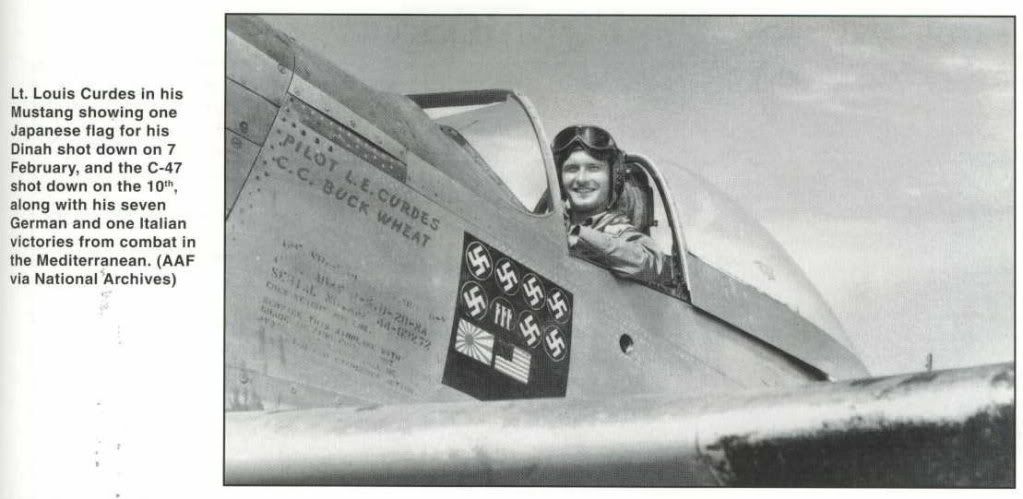He was captured, escaped, recaptured and escaped again and returned to his unit on May 27, 1944 and was sent back to Fort Wayne for leave. For his mission on August 27th, he was awarded thirteenth and fourteenth oak-leaf cluster to his Air Medal and the Purple Heart. <family corespondence>
http://www.82ndfightergroup.com/95misc%20-%20Louis%20E%20Curdes.htm While back in the United States, he volunteered for another combat tour and was re-assigned to the 4th Fighter Squadron, 3rd Air Commando Group flying P-51s in the Pacific Theatre.
After five months in the States, Curdes left for the Pacific Theatre arriving November 19. 1944. The mission of the 3rd Air Commando Group was to attack Japanese airfields and installations in the Philippines, support ground forces on Luzon, provide escort for missions to Formosa and the China coast, make raids on airfields and railways on Formosa, and furnish cover for convoys. Also transport personnel, drop supplies to ground troops and guerrilla forces, evacuate casualties from front-line strips, adjust artillery fire, and fly courier and mail routes.
On February 7, 1945, he shot down a Ki-46 “Dinah” while flying a P-51D thirty miles SW of Formosa. This feat made him one of three aces to have shot down enemy aircraft of all three Axis Powers.
February 10th was a day that truly set 1LT Curdes apart from all other Airmen. Curdes led a flight of four P-51s from a field at Mangaldan in Central Luzon to perform reconnaissance of the southern tip of Formosa. Their mission was to locate a small temporary airfield being used by the Japanese. Finding nothing there, they continued on to the northernmost of the Bataan Islands. Curdes and his wingman, Lt. Schmidtke flew over the northern half and the two other P-51s flown by Lieutenants. Scalley and La Croix took the southern half.
Suddenly Scalley called out that they were attacking a small field on Bataan Island and Curdes and Schmidtke joined them. La Croix’s aircraft was hit and he had to bail out. Curdes saw La Croix’s parachute open as his Mustang went into the water. La Croix climbed into a little rubber dingy that was part of the parachute pack. Curdes ordered Sculley back to base in order to get another flight out to provide cover for La Croix. Also Sculley was to see if a rescue PBY amphibian aircraft stationed at Linguyan was available. He told Schmidtke to climb to 15,000 feet and broadcast a “Mayday” and to provide cover for Curdes. Curdes would stay low to make sure that the Japanese didn’t try anything. Curdes made another strafing run on the airfield
When he pulled up, he saw a twin engine aircraft heading for Japanese held territory. Although it looked like a C-47, he wasn’t sure that it wasn’t a Japanese copy of a DC-2. He closed in and saw the American insignia on the aircraft. He attempted to contact the pilot of the aircraft using various VHF frequencies, but received no reply. The aircraft now went into its final approach glide to land on the strip below. Curdes dove in front of the aircraft three times to try and spoil the C-47s landing, but the pilot continued to try and land. Curdes fired a burst of machine gun fire across the nose of the aircraft, but the transport pilot ignored it. Finally Curdes decided that he would force the transport to ditch into the ocean.

Closing to within approximately twenty yards, he shot out the right engine, then the left. The plane hit the water and came to a stop with 50 yards from La Croix’s raft. Two large rubber dingies inflated and twelve personnel including two women climbed in. Curdes flew above the rafts and dropped a note that said “For God’s sake, keep away from shore. Japs there.” After seeing that they were safe, Curdes returned to flying protective cover. La Croix paddled over to the two dingies and tied them together.
The pilot of the transport became lost in bad weather, his radio had gone out and his fuel gauge read empty when he had sighted the landing field on Bataan. La Croix explained the situation to them.
Curdes continued to fly cover until four more Mustangs arrived to replace him and Schmidtke. A PBY came out at dawn the next morning to rescue La Croix and the others. After Curdes returned to base, he was in for a shock when he saw the names of the survivors of the transport. One of the nurses aboard that plane was the very same nurse that he had a date with the night before!

Curdes gave a start and a shout when he glanced at the names of the survivors. One of the nurses was the "date" he had been with the night
before at Lingayen.
"Jeepers," he exclaimed, "seven 109's and one Macci in North Africa, one Jap, and one Yank in the Pacific -- and to top it, I have to go out and shoot down the girl friend." <A Yank for Good Measure>
http://hs.novi.k12.mi.us/ww2/Burk_yank.pdfA few week's later, Captain Louis E. Curdes of the 4th Fighter Squadron. Third Air Commando Group was awarded the Distinguished Flying Cross
for shooting down a C-47.
General George Kenney, Commander of the Fifth Air Force awarded Curdes with his second Distinguished Flying Cross. On Curdes P-51 the “Bad Angel”, he now added a Japanese flag indicating the downing of the “Dinah” and an American Flag for the transport.
Lou Curdes returned back to the US in July 1945 and was discharged in September of 1946. Curdes’ post-WWII Summary of Military Occupations may best sum up his wartime experience.
Upon discharge, he joined the local Air National Guard unit at Baer Field and remained with them until 1948. He then returned to active duty serving in various assignments and participating in the Berlin Airlift. He retired as a Lieutenant Colonel on November 1, 1963.
